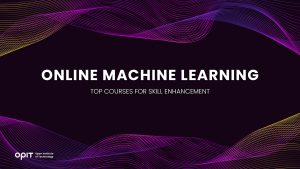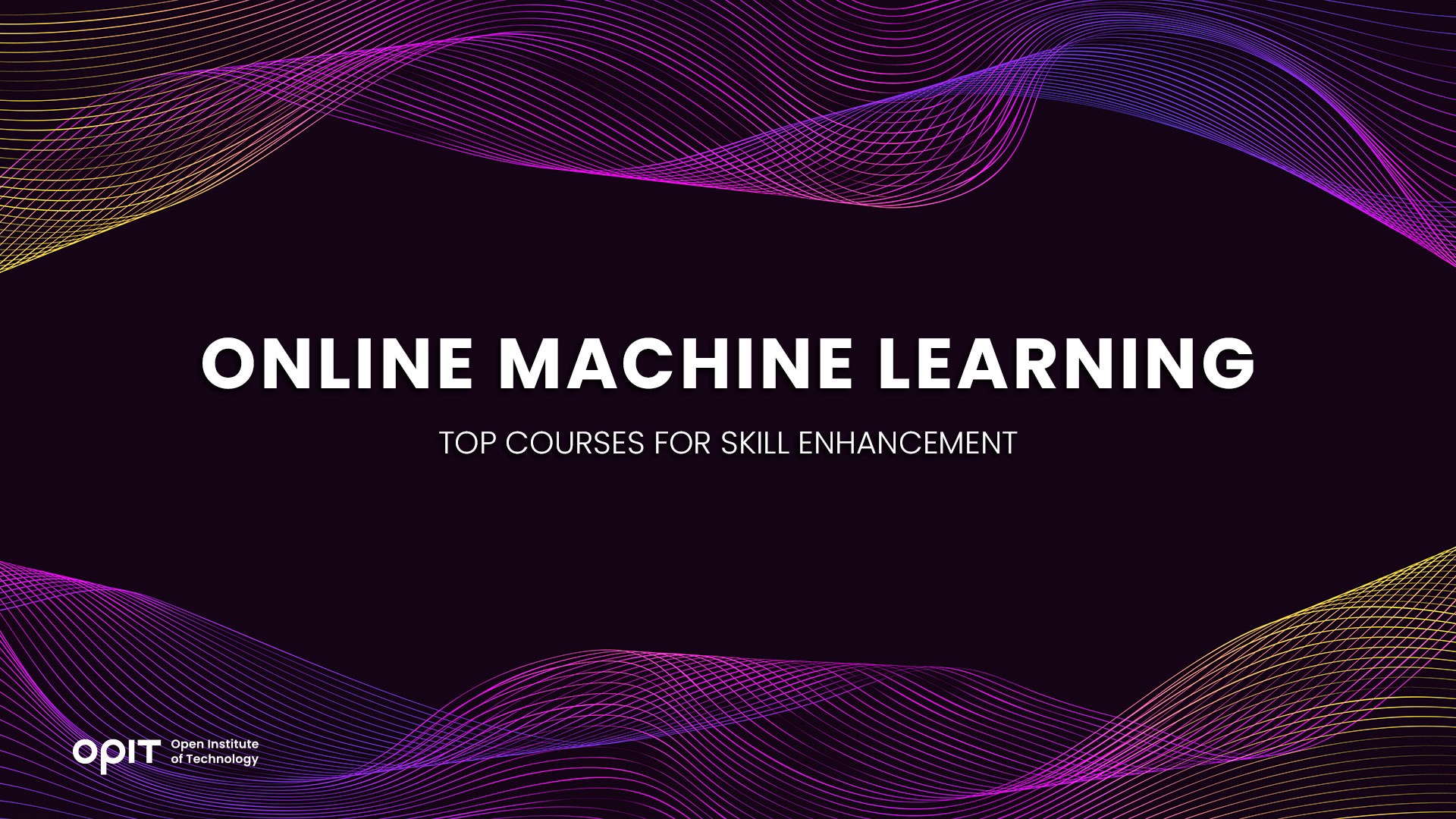

Once a concept found exclusively in science fiction, machine learning has seen widespread use in the modern age. As soon as various industries grasped the potential of ML, this field of computer science turned into a staple of tech and other businesses.
Naturally, all this has led to an increased demand for machine learning experts. The job market abounds with offers for positions in the field, and the competition is fierce. In other words, you may find plenty of job openings for machine learning professionals, but you’ll need to fit the bill to actually land the position.
Fortunately, there are plenty of online machine learning courses to give you the needed expertise and boost your skills. This article will help you find the best machine learning course online and explain the top options in detail.
Factors to Consider When Choosing an Online Machine Learning Course
If you like the idea of online learning, machine learning courses are readily available. In fact, the number of options may be overwhelming. That’s why we’ve applied certain strict criteria when looking for the best machine learning online course. Moving forward, you should also keep those criteria in mind.
Firstly, the content of the course will matter the most. Machine learning is a broad field, and you’ll want to ensure that the education you’re getting is the one you need. Also, every genuine venue of machine learning online training should give you a solid foundation while placing a particular emphasis to specific skills.
The curriculum won’t be the only aspect of the course that matters, though. Who is teaching you will be crucial as well. Ideally, your instructor should be an experienced professional in the field so that they can teach you the theory as well as the practical applications.
Next, one of the primary reasons why you’d want to take a course rather than enroll into a BSc or MSc program is time. You don’t want a course to take up too much of your time, which is why flexibility and the overall duration are essential. You’ll want a well-structured online machine learning course that will leave room for a job or any other activities.
Beside the knowledge provided, hands-on experience will be vital. Once you complete a course, you should be able to apply everything you’ve learned there. To that end, a quality machine learning online course will focus heavily on the real-world application of the skills taught.
Finally, the pricing will play a major role. Similar to time, budgetary concerns are likely a core reason why you’re opting for a course. Simply put, you don’t want it to cost the same as a year at a university. And if the price is somewhat higher, the course should provide plenty of additional resources to justify it.
Top Online Machine Learning Courses
Imperial College Business School – Professional Certificate in Machine Learning and Artificial Intelligence
Course Overview
This program deals with the essential AI and machine learning concepts, teaching you when and how ML solutions can be applied to real-life problems. The course is relatively long, lasting for 25 weeks. It was developed in collaboration with the Imperial College’s Department of Computing.
Key Features
- Taught by experts
- Hands-on activities
- Projects worthy of your portfolio
- Ends with a capstone project
- Verified digital certificate
Pricing and Additional Resources
The price of this course is £3,995, which is reasonable considering its extended duration. During the course, you’ll have individual advisor support for career-building. Completing your studies will also grant you the status of an Associate Alumni, allowing you to join the Imperial College Business School’s community.
Google Digital Garage – Machine Learning Crash Course
Course Overview
If you want to learn machine learning fundamentals quickly and efficiently, this course is just the ticket. It includes comprehensive text and video lectures, practical exercises, and work with the TensorFlow ML library. You’ll gain relevant knowledge and experience through three modules lasting a total of 15 hours.
Key Features
- Lecturers are Google’s researchers
- Intermediate level
- Genuine case studies
- Interactive algorithm showcases
- Fast-paced and applicable
Pricing and Additional Resources
If you’re wondering how much a course from a leading tech giant company may cost, you’ll be pleasantly surprised: This Google machine learning online course is absolutely free. In addition, it’s quite short and very efficient.
IBM (via edX) – Machine Learning With Python: A Practical Introduction
Course Overview
This course teaches you supervised and unsupervised machine learning using Python. An introductory course, it may last up to five weeks. Best of all, the program is entirely self-paced, meaning you can tackle individual lessons at a tempo that suits you. It’s worth noting that this course also explores widely used models and algorithms, supported by actual examples.
Key Features
- Taught by a Senior Data Scientists at IBM
- Part of IBM’s one year certificate program for data science professionals
- Beginner-friendly
- Focus on statistics and data analysis
Pricing and Additional Resources
Like Google’s course, this program by IBM, hosted on edX, is free. It’s worth noting that there’s also a “Verified Track” version, priced on edX at $99. This version of the course will provide unlimited source material access, exams, graded assignments, and a shareable certificate.
DeepLearning.AI (via Coursera) – Unsupervised Learning, Recommenders, Reinforcement Learning
Course Overview
As a part of a specialization in machine learning, this course teaches unsupervised learning as a particular branch of ML. You’ll also learn about recommender systems and how to build certain machine learning models. The course is designed by experienced DeepLearning.AI members in collaboration with Stanford University. You’ll be able to complete it in about 27 hours.
Key Features
- Flexible course scheduling
- Part of a three-course specialization
- Taught by an experienced lecturer and ML professional
- Beginner-friendly
- Teaches specific machine learning techniques
Pricing and Additional Resources
This course, as well as the entire specialization, is available with a Coursera subscription. As a subscriber, you won’t pay any additional fees for the course. Plus, you’ll gain access to a shareable certificate, practice and graded quizzes, and other subscriber benefits.
Microsoft – Foundations of Data Science for Machine Learning
Course Overview
More than a regular course, Foundations of Data Science for Machine Learning is a learning path which consists of 14 modules. It will take you through the entire journey, from the machine learning basics to advanced architecture and data analysis. The course can be completed in under 13 hours.
Key Features
- Offered by a leading tech giant
- Provides lessons and exercises
- Entirely browser-based
- Interactive learning
Pricing and Additional Resources
This training course by Microsoft is free and available immediately. Enrolling in the course comes with no prerequisites.
Tips for Success in Online Machine Learning Courses
Once you choose a machine learning online course, simply signing up for it won’t be enough. You’ll want to ensure you’re getting the most value out of the program. To that end, it would be best to apply the following tips:
- Set your goals and expectations: The best way to get optimal results from a course is to go into it knowing precisely what you want. Clarify what you’re looking to achieve and what you expect the course to provide, and you’ll have an easier time both choosing and completing the program.
- Dedicate time to study and practice: Course lectures will be a vital part of the learning process, but the time and work you put into it will be what makes it all worthwhile. Approach your machine learning online course with the utmost dedication and responsibility, making sure to always set aside the time of day for studying.
- Engage with the community: A learning environment is perfect for building a network. You’ll contact other people with similar interests, which may broaden your viewpoint, provide additional knowledge, and even open up job opportunities. Don’t shy away from online forums or any other type of meeting place that your peers frequent.
- Try out new skills and concepts in real-life: Even if the course you pick involves practical projects, you should be proactive beyond that point. Take what you’ve learned and try to apply it on something outside the course. The best time to start practicing is as soon as you learn a new skill.
- Keep updating your knowledge and skills: Machine learning progresses rapidly, so you’ll have to do your best in keeping your knowledge and skills relevant. A quality course will give you a good foundation. However, updating what you’ve learned will be entirely up to you.
Become a Machine Learning Expert Online
If you’ve found the best machine learning course online for your purposes, you should start learning right away. Armed with the proper skills, you’ll have greater chances of getting work in the industry and starting a career in this science of the future.
Explore which machine learning online course fits you best and start pursuing your goals. You’ll find the knowledge and experience gained as the perfect catalysts for personal and professional growth.
Related posts

2025 has come to a close, with 2026 already underway. There are many exciting events ahead and future milestones to aim for and look forward to. But it’s also the ideal time to look back over the last 12 months, exploring the most notable achievements we’ve made, lessons we’ve learned, and important moments to reflect on as the new year continues for OPIT’s staff, students, and broader community.
1. Student Commitment
Studying isn’t always easy. It involves long days, and even long evenings sometimes, with a seemingly never-ending series of tasks to accomplish and goals to aim for. It can take a lot out of even the most hard-working and dedicated individuals.
Yet, despite the hardships and challenges, OPIT students demonstrated remarkable resilience, continuous curiosity, and indefatigable determination throughout 2025. Looking back on the year, students at all levels of the OPIT community should feel proud and celebrate their accomplishments.
2. Podcast Launch
2025 saw a lot of new arrivals at OPIT, with fresh projects and innovations arriving on the scene. Chief among them was the OPIT EDGE Podcast, an exciting addition to the institute’s ever-expanding multimedia offerings.
There have already been several episodes of the podcast for students and technology enthusiasts in general to enjoy, with the first episode of this student-driven project involving an in-depth discussion with industry expert Matteo Zangani on the potential of quantum AI technology.
3. Success Stories
While many new students have joined the OPIT ranks in 2025 and will also do so in 2026, others have now achieved their educational objectives and are already moving on to the next exciting steps and chapters in their personal and professional lives.
There are so many inspiring success stories from the last 12 months, it’s impossible to list them all. But just one notable example has to be Maria Brilaki, who recently concluded her Master’s in Responsible AI, defending a powerful thesis related to non-invasive glucose monitoring through near-infrared spectroscopy and machine learning.
4. Graduation in Malta
2025 was a big year of firsts for OPIT, including the institute’s first official graduation ceremony, which took place on March 8 at a grand ceremony in Malta, honoring the achievements of dozens of applied data science and AI graduates.
The hybrid event was open to both in-person and virtual attendees, bringing together members of the OPIT community from across the world. It was a huge moment for the graduates themselves and a thrilling milestone for OPI – a testament to all the hard work that has gone into building this institute.
5. OPIT AI Copilot
Artificial intelligence is the technology of the moment, and OPIT isn’t just dedicated to teaching the next-generation of technology leaders how to work with AI responsibly and efficiently; it’s also interested in harnessing the powers and potential of AI to improve its educational offerings, too.
This culminated in the development and release of OPIT AI Copilot in 2025. This groundbreaking AI tool now provides real-time, personalized learning support, along with contextual assistance, and is available on a round-the-clock basis for students to turn to, as and when they feel the need.
6. Hackathons
2025 also saw OPIT students and faculty take more active roles in various events, including hackathons. In November, for example, OPIT got involved with the 6th edition of the ESCP Hackathon, with several students entering as developers.
This was an exciting and unique opportunity for those students to meet up in person, put the skills they’ve honed during their time at OPIT to the test in a challenging environment, and learn from one another. OPIT will surely participate in more hackathons in the years to come, so stay tuned for more details on upcoming events and how you can play your part.
7. Strengthening Collaboration
From day one, OPIT has focused on building a strong network of established technology and business partners, opening doors and providing opportunities for both education and employment for its students.
This continued throughout 2025, with OPIT strengthening its connections with a number of world-leading organizations, including Accenture, AWS, Hype, Buffetti, and more. Through events like hackathons, career fairs, and more, OPIT makes the most of its ever-expanding and increasingly impressive professional network.
8. Online Career Fair
Another big first for 2025 was the inaugural OPIT Online Career Fair, an event that was held on November 19 and 20, with more than a dozen established and emerging companies from around the world in attendance, including the likes of Deloitte, Tinexta Cyber, Datapizza, RWS Group, Planet Farms, and Nesperia Group.
The only nature of this event ensured that students all enjoyed equal access, no matter where they were based, and everyone was able to hear from industry experts and enjoy the unique array of opportunities on offer, forging their own connections and learning more about brands they might like to work with or for in the future.
9. Education Innovation
OPIT has always been about innovating, delivering newer and smarter ways to learn for students across the globe, no matter their background, budget, or social class. And the institute has continually innovated over the course of 2025, helping students learn skills and broaden their knowledge efficiently and intuitively.
As we enter 2026, OPIT’s innovation is set to be on full display once more, with no less than two new courses for new applicants to choose from: AI-Driven Software Development (Elective) and Business Intelligence and Decision Making (Elective).
10. The Power of the OPIT Community
Perhaps the crowning achievement for OPIT in 2025 was the demonstrable success of not just individual students or faculty members, but the entire OPIT community, as a whole. Everyone, from alumni to new students and seasoned staff members, played their part in the institute’s success, paving the way for more great things and major milestones in 2026 and beyond.
As OPIT Rector and former Italian Minister of Education, Francesco Profumo, puts it:
“What inspires me most is the mindset of our students: forward-looking, responsible, and driven by a desire not just to succeed, but to contribute. Their dedication reminds us why education remains one of the most powerful forces for shaping the future.”

Bring talented tech experts together, set them a challenge, and give them a deadline. Then, let them loose and watch the magic happen. That, in a nutshell, is what hackathons are all about. They’re proven to be among the most productive tech events when it comes to solving problems and accelerating innovation.
What Is a Hackathon?
Put simply, a hackathon is a short-term event – often lasting just a couple of days, or sometimes even only a matter of hours – where tech experts come together to solve a specific problem or come up with ideas based on a central theme or topic. As an example, teams might be tasked with discovering a new way to use AI in marketing or to create an app aimed at improving student life.
The term combines the words “hack” and “marathon,” due to how participants (hackers or programmers) are encouraged to work around-the-clock to create a prototype, proof-of-concept, or new solution. It’s similar to how marathon runners are encouraged to keep running, putting their skills and endurance to the test in a race to the finish line.
The Benefits of Hackathons
Hackathons provide value both for the companies that organize them and the people who take part. Companies can use them to quickly discover new ideas or overcome challenges, for example, while participants can enjoy testing their skills, innovating, networking, and working either alone or as part of a larger team.
Benefits for Companies and Sponsors
Many of the world’s biggest brands have come to rely on hackathons as ways to drive innovation and uncover new products, services, and opportunities. Meta, for example, the brand behind Facebook, has organized dozens of hackathons, some of which have led to the development of well-known Facebook features, like the “Like” button. Here’s how hackathons help companies:
- Accelerate Innovation: In fast-moving fields like technology, companies can’t always afford to spend months or years working on new products or features. They need to be able to solve problems quickly, and hackathons create the necessary conditions to deliver rapid success.
- Employee Development: Leading companies like Meta have started to use annual hackathons as a way to not only test their workforce’s skills but to give employees opportunities to push themselves and broaden their skill sets.
- Internal Networking: Hackathons also double up as networking events. They give employees from different teams, departments, or branches the chance to work with and learn from one another. This, in turn, can promote or reinforce team-oriented work cultures.
- Talent Spotting: Talents sometimes go unnoticed, but hackathons give your workforce’s hidden gems a chance to shine. They’re terrific opportunities to see who your best problem solvers and most creative thinkers at.
- Improving Reputation: Organizing regular hackathons helps set companies apart from their competitors, demonstrating their commitment to innovation and their willingness to embrace new ideas. If you want your brand to seem more forward-thinking and innovative, embracing hackathons is a great way to go about it.
Benefits for Participants
The hackers, developers, students, engineers, and other people who take part in hackathons arguably enjoy even bigger and better benefits than the businesses behind them. These events are often invaluable when it comes to upskilling, networking, and growing, both personally and professionally. Here are some of the main benefits for participants, explained:
- Learning and Improvement: Hackathons are golden opportunities for participants to gain knowledge and skills. They essentially force people to work together, sharing ideas, contributing to the collective, and pushing their own boundaries in pursuit of a common goal.
- Networking: While some hackathons are purely internal, others bring together different teams or groups of people from different schools, businesses, and places around the world. This can be wonderful for forming connections with like-minded individuals.
- Sense of Pride: Everyone feels a sense of pride after accomplishing a project or achieving a goal, but this often comes at the end of weeks or months of effort. With hackathons, participants can enjoy that same satisfying feeling after just a few hours or a couple of days of hard work.
- Testing Oneself: A hackathon is an amazing chance to put one’s skills to the test and see what one is truly capable of when given a set goal to aim for and a deadline to meet. Many participants are surprised to see how well they respond to these conditions.
- Boosting Skills: Hackathons provide the necessary conditions to hone and improve a range of core soft skills, such as teamwork, communication, problem-solving, organization, and punctuality. By the end, participants often emerge with more confidence in their abilities.
Hackathons at OPIT
The Open Institute of Technology (OPIT) understands the unique value of hackathons and has played its part in sponsoring these kinds of events in the past. OPIT was one of the sponsors behind ESCPHackathon 6, for example, which involved 120 students given AI-related tasks, with mentorship and guidance from senior professionals and developers from established brands along the way.
Marco Fediuc, one of the participants, summed up the mood in his comments:
“The hackathon was a truly rewarding experience. I had the pleasure of meeting OPIT classmates and staff and getting to know them better, the chance to collaborate with brilliant minds, and the opportunity to take part in an exciting and fun event.
“Participating turned out to be very useful because I had the chance to work in a fast-paced, competitive environment, and it taught me what it means to stay calm and perform under pressure… To prospective Computer Science students, should a similar opportunity arise, I can clearly say: Don’t underestimate yourselves!”
The new year will also see the arrival of OPIT Hackathon 2026, giving more students the chance to test their skills, broaden their networks, and enjoy the one-of-a-kind experiences that these events never fail to deliver. This event is scheduled to be held February 13-15, 2026, and is open to all OPIT Bachelor’s and Master’s students, along with recent graduates. Interested parties have until February 1 to register.
Have questions?
Visit our FAQ page or get in touch with us!
Write us at +39 335 576 0263
Get in touch at hello@opit.com
Talk to one of our Study Advisors
We are international
We can speak in:


